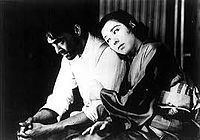7.2 /10 1 Votes7.2
Release date November 24, 1932 Initial release 24 November 1932 Production company Shochiku | 7.3/10 IMDb Produced by Shōchiku Eiga Edited by Hideo Shigehara Running time 103 min Written by Kogo Noda | |||||||||||||||||||||||||||||||||
 | ||||||||||||||||||||||||||||||||||
Cinematography Yûharu Atsuta, Hideo Shigehara Similar The Luck Which Touched t, Treasure Mountain, Fighting Friends, Dreams of Youth, Walk Cheerfully | ||||||||||||||||||||||||||||||||||
Mata au hi made (English title: Until the Day We Meet Again) is a lost 1932 Japanese film. It was the first sound film directed by Yasujirō Ozu.
Contents
Plot
A romance between a young soldier and a prostitute unfolds over the course of one night.
Production
According to Ozu's recollections, Mata au hi made was made a year after the release of the first Japanese talkie, Madamu to nubo (The Neighbour's Wife and Mine). The director, who had initially resisted the trend towards talking pictures, agreed to use an experimental sound process developed by Hideo Mohara, rather than the more popular Dobashi sound system. The film apparently contained a musical track and sound effects but no audible dialog scenes.
Cast
References
Until the Day We Meet Again Wikipedia(Text) CC BY-SA
